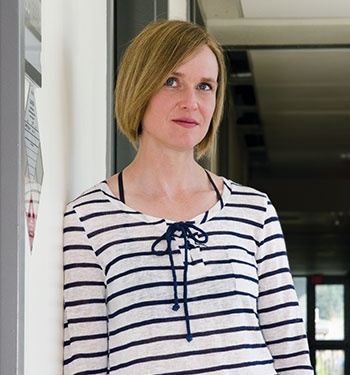Study shows females under-represented in top research journals
After an in-depth study, a UBC Okanagan researcher says almost every aspect of two top science journals continue to under-represent women—from published articles to photos, feature profiles and even advertisements.
Associate Professor Miranda Hart, who teaches biology in the Irving K Barber School of Arts and Sciences, is an avid reader of two science publications—Nature and Science. Whether it’s unintended or not, Hart says there is a definite discrepancy in the representation of men over women in these two leading journals.

Miranda Hart, associate professor of biology in the Irving K Barber School of Arts and Sciences.
“Publications like Science and Nature are a window into scientific culture,” says Hart. “These journals reflect what scientific role models look like, including gender stereotypes.”
The idea first occurred to her while flipping through issues of these journals at home.
“I became so tired of seeing page after page after page of men,” she says. “There were profiles of men, men doing science and men recruiting men to science. It was so disappointing and I was starting to get sick of reading them.”
Hart realized it would be easy to do a comparative study and actually count how many articles, images and advertisements included men or women. And what those images portray.
For her study, Hart and undergrad researcher Becky Loverock looked at three months of issues of Science and Nature to see if women and men were truly represented differently in terms of authorship and images. Her study confirmed her belief about gender bias in both journals, with women accounting for less than 15 per cent of all corresponding authors published during that three-month period. More surprisingly, notes Hart, women were grossly underrepresented in photographs, advertisements and stock photographs.
“I thought ‘is it just me?’ But when we looked back through three months of issues and started quantifying the numbers of pictures, articles and profiles, it became very clear,” Hart says. “Despite societal awareness, gender bias persists. These magazines are perpetrating a role model that is predominantly, and sometimes exclusively, male.”
“Elite journals such as Science and Nature carry significant weight in their ability to influence the scientific culture. They reflect who is doing science, and what scientists look like,” says Hart. “Changing gender stereotypes requires exposure to counter stereotypes and these journals have an important role to play in this change.”
Hart’s study was recently published in FACETS.
About UBC's Okanagan campus
UBC’s Okanagan campus is an innovative hub for research and learning in the heart of British Columbia’s stunning Okanagan Valley. Ranked among the top 20 public universities in the world, UBC is home to bold thinking and discoveries that make a difference. Established in 2005, the Okanagan campus combines a globally recognized UBC education with a tight-knit and entrepreneurial community that welcomes students and faculty from around the world. For more visit ok.ubc.ca.
 Police watchdog called in
Police watchdog called in Mayor calls 'BS' on list
Mayor calls 'BS' on list U.S. authorities find bodies
U.S. authorities find bodies Premier stands by pick
Premier stands by pick Canada's most-wanted list
Canada's most-wanted list Sask. will still get rebates
Sask. will still get rebates Santos ends comeback bid
Santos ends comeback bid Douglas C-54 plane crashes
Douglas C-54 plane crashes Trump's 'eyes and ears'
Trump's 'eyes and ears' US TikTok ban sent to Biden
US TikTok ban sent to Biden Phish fans enter the Sphere
Phish fans enter the Sphere CN Rail profits fall
CN Rail profits fall  Warriors snakebitten in loss
Warriors snakebitten in loss Iginla off to Europe
Iginla off to Europe Rockets ink prospect
Rockets ink prospect Alleged Tupac killer in court
Alleged Tupac killer in court Lawsuit accuses Megan
Lawsuit accuses Megan Bam Margera’s tour axed
Bam Margera’s tour axed



